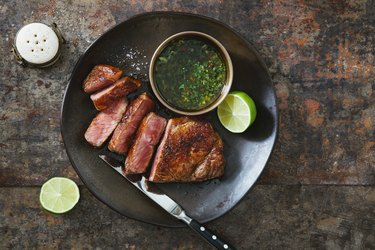
Humans have evolved to eat meat, so the human body comes equipped with specialized enzymes that break down the tough proteins and fats in meats like beef. But beef digestion is harder for the body to than some plant-based foods, because it's entirely protein and fat.
Foods high in these macronutrients can be hard to digest foods. Both protein and fat are more difficult for the body to break down than carbohydrates, the primary macronutrient in many plant-based foods.
Video of the Day
Video of the Day
Read more: How to Cook a Tender Steak on the Stove
Early Stages of Beef Digestion
Your body begins breaking down your food when you take your first bite. The mashing of your teeth starts to break the beef down into smaller pieces, creating more surface area for gastric, intestinal and pancreatic juices and specialized enzymes to do their work.
But carbohydrates are the only macronutrient where chemical digestion begins in the mouth; the chemical digestion of protein and fat doesn't start until later in the process.
Understand Protein Digestion
According to the USDA, a 3-ounce portion of grilled beef tenderloin, trimmed of fat, has 26 grams of protein, all of which your body needs to break down into amino acids. Your body then uses these aminos to fulfill different functions, including building muscle and supporting your immune system.
According to Mansoura University, the digestion of protein begins in the stomach, where stomach acid and an enzyme called pepsin start breaking apart the protein bonds.
Next, protein passes to the small intestine, where enzymes from the pancreas and intestinal juices further break down the protein bonds to amino acids, ready for absorption into the bloodstream.
Breakdown the Fat
The same portion of grilled tenderloin also contains 8.3 grams of fat. Fat digestion doesn't begin until the food reaches the small intestine. Here, bile salts emulsify the fat molecules so that pancreatic enzymes called lipases can more easily break the fats down into free fatty acids and monoglycerides.
These then pass into the epithelial cells that line the intestines, where they're converted into triglycerides. Bundled with cholesterol and covered with protein, the triglycerides are ready for absorption into the bloodstream for transportation to where the body needs them.
Aiding Beef Digestion
Fattier cuts of beef will be more difficult for the body to digest, so if you find that you have trouble digesting beef, choosing leaner cuts can help. Chew the beef thoroughly before swallowing it, to aid digestion once the meat reaches the stomach.
To ease digestion, avoid eating large amounts of beef, especially if you don't usually eat much. If you continue to have trouble digesting meat, see your doctor; you could have an intolerance of or even an allergy to beef.
Beware Beef Intolerance
According to the American College of Allergy, Asthma & Immunology, digestive issues experienced while eating beef can be a sign of an allergy. This allergy can develop from a Lone Star tick bite.
In addition to indigestion, a meat allergy can cause vomiting, diarrhea and stomach cramps. Other symptoms of allergic reaction include hives, throat tightening, weak pulse, dizziness, swelling in the mouth area, confusion and shortness of breath. Seek immediate medical attention, as these symptoms can become life-threatening.